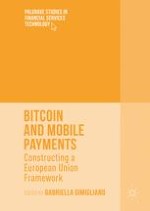2016 | OriginalPaper | Buchkapitel
6. M-Payments: How Much Regulation Is Appropriate? Learning from the Global Experience
verfasst von : Elisabetta Cervone
Erschienen in: Bitcoin and Mobile Payments
Verlag: Palgrave Macmillan UK
Aktivieren Sie unsere intelligente Suche, um passende Fachinhalte oder Patente zu finden.
Wählen Sie Textabschnitte aus um mit Künstlicher Intelligenz passenden Patente zu finden. powered by
Markieren Sie Textabschnitte, um KI-gestützt weitere passende Inhalte zu finden. powered by
